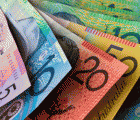Citing strong domestic economic conditions and concerns about the build
up of inflationary pressures, the
RBA decided to lift official interest rates by 0.25
percentage points taking official interest rates to 7.0 per cent, their highest
level since July 1996.
This latest rate hike represents the eleventh consecutive rise in official
interest rates. The current tightening cycle commenced in May 2002 when
official interest rates were raised from 4.25 per cent to 4.5 per
cent.
Printing
Industries National Policy and Research Manager, Hagop Tchamkertenian
(pictured right), said the decision to lift official interest rates had already
been factored in by the markets when the inflation data was released in late
January.
"With underlying inflation currently running at 3.6 per cent the RBA
was compelled to act," he said.
"We need to now wait and see whether the recent increases will be
sufficient to help slow down domestic activity and start impacting on
inflationary pressures."
Tchamkertenian said the government now faced a serious dilemma – on
one hand the RBA is tightening monetary policy, while on the
other the government is offering a series of tax
cuts which may continue to boost domestic demand.
"Based on my estimates the November decision to lift rates combined
with today's decision has raised the annual interest cost of servicing mortgage
and consumer debt by almost $4 billion," he said.
"Yet we know that the government remains committed to honouring its
pre-election pledge of delivering tax cuts. The forthcoming tax cuts are
estimated to deliver more than $6 billion to households."
Tchamkertenian recommended that printing companies reconsider their 2008
business plans in the wake of the latest interest rate increase and factor
in more subdued economic growth.
"Under normal conditions the printing industry is expected
to benefit from any stimulus given to domestic demand such as tax
cuts. However, households knowing that the RBA is determined to bring inflation
under control by lowering inflationary pressures may be inclined to
save rather than spend their tax cuts.
"Under such a scenario the forthcoming tax cuts
may not provide the same level of stimulus to domestic demand as past
tax cuts. And with interest rates also rising, the printing and associated
industries are likely to be negatively impacted," he said.
Comment below to have your say on this story.
If you have a news story or tip-off, get in touch at editorial@sprinter.com.au.
Sign up to the Sprinter newsletter


